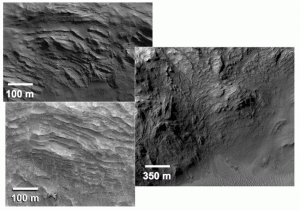A study examining layered “megablocks” of lava in the central parts of Mars craters concludes that flood lavas in the Hesperian epoch were at least 23 percent thicker than previously known. The research says this shows there has been more extrusive volcanism, and a greater release of volatiles, than earlier work indicated.

TUMBLED MEGABLOCKS. These steeply tilted, layered blocks were found in crater central peaks, and are thought to be layers of lava and related sediments. New research that carefully measured the thickness of such blocks boosts the known amount of layered lava deposits by more than 20 percent. This indicates much more lava flooded out during earlier Martian epochs than previously estimated, and this in turn must have affected past climates. (Image taken from Figure 2 in the paper.)
The multi-author study was led by Christy Caudill (University of Arizona) and published in Icarus (September 14, 2012). The research used THEMIS nighttime infrared imagery to locate areas showing potential bedrock. (The team notes they omitted areas in high-latitude polar regions and areas with dense dust or surface cover, such as Arabia Terra.)
Using the HiRISE camera on the Mars Reconnaissance Orbiter, the researchers focused primarily on what they identified as “Layered MegaBlock bedrock” exposures. These are pieces of bedrock hundreds of meters to a kilometer in size, uplifted and tilted by crater-making impacts. Such megablocks show a great many layers with thicknesses of several meters to tens of meters.
The team reports, “This distinctive morphology, found in 41 craters globally, occurs mostly in regions mapped as Hesperian-age plains material and generally interpreted as regions of extensive flood lavas.” Mars scientists date the Hesperian as lasting from about 3.9 to 3.0 billion years ago.
“Coupled with crater-scaling techniques and the regional geologic context, we use these observations to estimate the source depths of Layered MegaBlock material and, by extension, constrain a total volume,” the researchers say.
The Hesperian epoch had slower rates of impacts, weathering, and erosion compared to the earlier Noachian, as the team notes. In addition, the Hesperian had high average rates of volcanic activity, about ten times that of the Amazonian epoch that followed. “Hesperian-aged ridged plains have been mapped over extensive regions of Mars and have been interpreted to be volcanic flood lavas,” they say.
Using HiRISE images, the researchers measured the thicknesses and orientation of individual layers in the volcanic flood lavas as well as the depth of the source where the uptilted blocks came from. They noted that “layered and stratified rocks on Mars are usually not oriented at a high enough tilt to easily infer their geometries from orbital imaging.” However, the researchers focused on layers that were uplifted and rotated to orientations that allowed them to note properties such as strike, dip, and layer thickness.
Further work allowed volume computations, which the team acknowledges are “quite a challenge, considering the paucity of stratigraphic exposures on Mars to study the depths of flood lavas over time.”
The scientists explain that, “In contrast to previous methods, we use the section uplift of craters that expose pre-impact bedrock and thus provide information about the subsurface. This study’s calculated volumes for the Layered MegaBlock material therefore produce an alternate estimate for extrusive minimums, raising the estimate during this period to 55 million cubic kilometers.”
They add that, “Our values may also be an underestimate of total Hesperian extrusives because most of the craters do not expose the deepest layers.”
The researchers conclude, “If this material indeed represents late Noachian and Hesperian extrusives, our volume estimates indicate a 22.8 percent increase when compared with previous estimates.” This, they note, must have affected the climate on Mars during ancient times.








